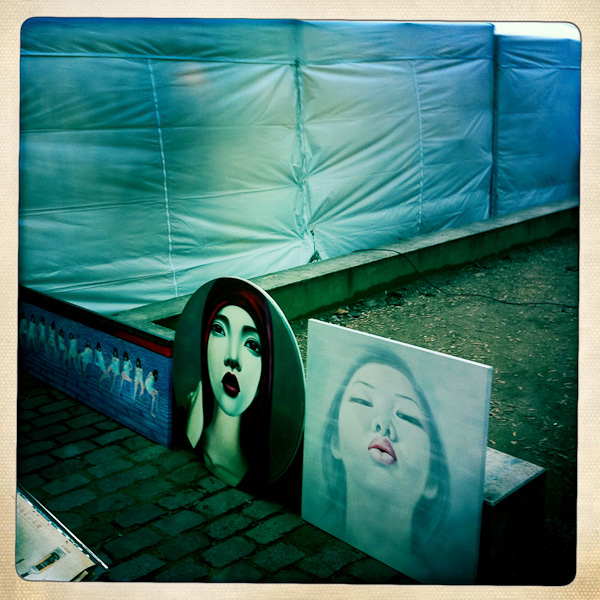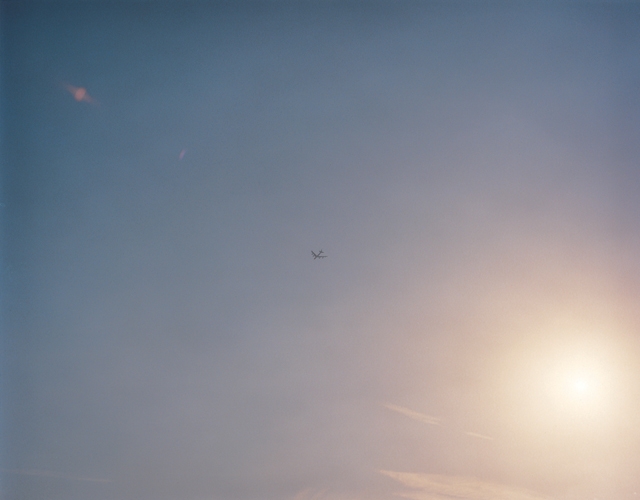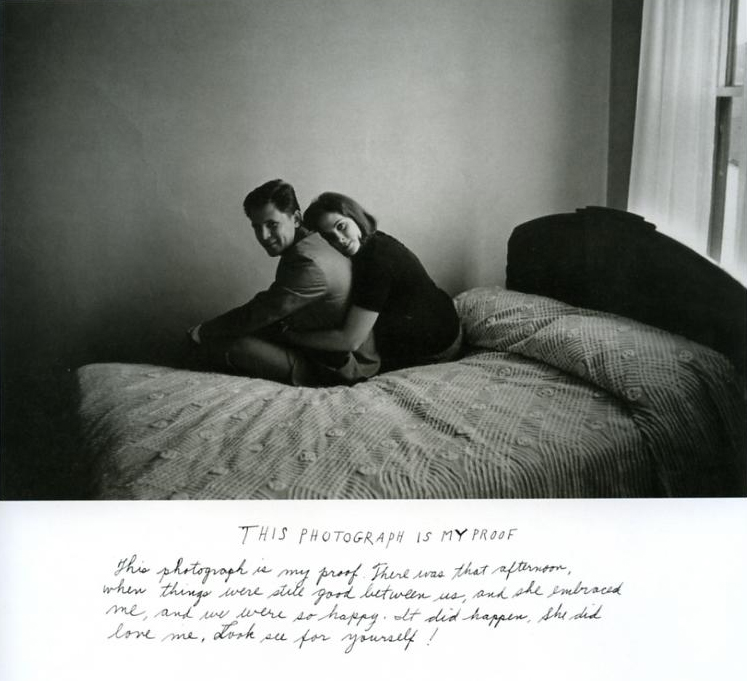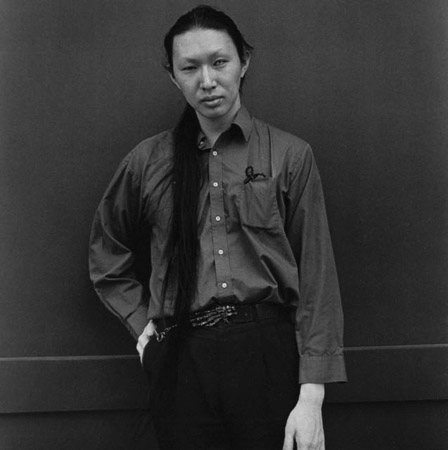Loving this short film montage by Mishka Henner and David Oates, collectively known as BlackLab. By extracting and resequencing hundreds of movie scenes featuring photographers, Photographers explores the tropes of the photographer on screen from voyeur, to fashion photographer, investigator or war photographer. Beyond the fun of trying to figure out what films were used for the montage, this is also a fascinating deconstruction of the mythology of the photographer.
Review: Will Steacy (ed.), Photographs Not Taken
We live in the age of photo proliferation. Digital technology in all its forms (cameras, phones, computers, the Internet) has made photography the most democratic of media, both in terms of making and disseminating images. And they are everywhere, all the time: on our TVs, our computer screens, our smartphones and in our streets. Of course, this state of affairs is not as new as we might think—it has been in place since Walter Benjamin and his age of mechanical reproduction—but digital technology has led this proliferation to take off exponentially.
The impact of this is clear, even in traditional, 'purist' photography circles. In 2007 the Musée de l'Elysée in Lausanne created a crowd-sourced exhibition entitled We Are All Photographers Now, allowing anyone to upload their photographs to be included in the show. More recently Europe's biggest photo-festival, the Rencontres d'Arles, centred on an exhibition entitled From Here On, a kind of manifesto for the age of the online image ("Now we're a species of editors. We all recycle, clip and cut, remix and upload. We can make images do anything.") where much of the work was made by artists appropriating or collecting other people's images. Even Elliot Erwitt has been saying that more pictures are better than one. So what a relief to open a photobook (am I allowed to call it that?) and discover that it does not contain a single picture: the cover's 'empty' frame is the closest thing to an actual photograph.
Photographs Not Taken is a collection of essays about photographs that, for one reason or another, did not end up being taken. The writer and photographer Will Steacy, who edited the volume, asked an eclectic group of photographers (Emmet Gowin, Tim Hetherington, Laurel Nakadate and Jamel Shabazz all feature to give you an idea of the mix) to "abandon the conventional tools needed to make a photograph–camera, lens, film—and instead make a photograph using words." The book is both a collection of opportunities missed, of attempts to conjure up in words those images that got away, but also a look into the psychology of the photographer and their ethics, reflexes, and methods.
Naturally many of these non-photographs were not taken because of an ethical or moral decision by the photographer, a decision that photojournalists must face on a day-to-day basis. Interestingly, many of the writers contrasted the act of taking a photograph with the state of being present as a human being. In these cases the camera is described as a defense to hide behind, with which to shield the photographer from the impact of the moment happening in front of or to them. The book also has its more surreal moments: Matt Salacuse describes the scientologist jedi mind trickery of Tom Cruise forcing him to lower his camera and to pass up the opportunity of photographing Cruise and Kidman's newborn adopted baby.
It must be said that the essays are uneven... after all this is a collection of texts by photographers and not by writers. I found that some of the texts failed to bring the images to life, or perhaps that too many of these images ended up 'sounding' the same. For me Roger Ballen's essay stood out: he avoids any explanation of why he didn't photograph the scene he describes (did he even have a camera with him on that day?), but there is no question whose world this lost moment belonged to. Rather than in attempting to resurrect lost images through words, an exercise that surely would be better accomplished by a group of writers, I found Photographs Not Taken to be most successful when it makes the reader think about the decisions that go into making, or not making a photograph. And if it encourages us to put down our cameras from time to time, that can only be a good thing.
Note: The International Center of Photography in New York will be hosting a book signing with several of the contributors on Friday, March 23rd from 6:00-7:30 p.m.
Will Steacy (ed.), Photographs Not Taken, (Daylight, 2012).
Rating: Worth a look
Review: Donald Weber, Interrogations
The title of Donald Weber's latest book, Interrogations, is very appropriate: both because they are the book's subject, but also because this book raises a number of difficult questions which it deliberately refuses to answer. Set in Russia and the Ukraine, the book is made up of a series of portraits of people being questioned in different interrogation rooms, each as sparse as the next. By choosing not to include any captions and very little information about the context of these interrogations, Weber has put together a book which is an unflinching and discomfiting encounter with a particularly brutal and raw manifestation of power.
Although the interrogations themselves are book-ended by a prologue and an epilogue, these provide limited context. The prologue consists of images which set a mood for the book. They depict a bleak, difficult world punctuated by a few moments of natural beauty and provide an abstract sense of life in these parts. They also serve as a reminder that Weber did not parachute in to shoot his portraits but spent close to six years shooting in the region. Rather than showing us the specific worlds or lives of the subjects of the interrogations, the prologue creates a sense of foreboding for what is to come.
The epilogue—a longer essay by Larry Frolick and two shorter pieces by Frolick and Weber and by Weber on his own—refuses to provide much context either. Like the book's photographic introduction Frolick's essay is also a mood piece documenting a difficult trip that Frolick took with his Ukrainian fixer, an echo of the bleakness, strength and the violence of the world photographed by Weber.
As an object, the book is very well made. Its size, unusual 'vertical' format and the full-bleed one-per-spread treatment of the portraits all contribute to its intensity. The cover is initially a little confusing, until the portraits reveal that it replicates the cheap, textured wall of one of the interrogation rooms, a clever design feature.
Naturally the meat of the book is the portraits themselves. Taken in a handful of dingy, sparse interrogation rooms, they show different people undergoing a psychologically and sometimes physically violent interrogation process. We are not told who these people are are, what they are accused of, or why they are being interrogated. Indeed the book only indirectly reveals that these photographs were not staged and were taken during real interrogations. As one portrait follows the next, the emotions intensify. Concern and defensiveness give way to terror, panic and perhaps most alarmingly to expressionless faces, the faces of people whose spirit has been broken. The claustrophobia and tension of these portraits is heightened as the interrogators are never revealed. The few glimpses that Weber affords us are manifestations of pure violence and intimidation: a hand outstretched to grab a man or to strike another on the back of the head. In two of the most shocking portraits an interrogator presses a gun to the head of their subject.
Weber prides himself on his unflinching gaze and this comes through clearly in these portraits. Just as for those being interrogated, there is no respite or redemption in the book: we are 'forced' to stare head on at raw terror, at the loss of dignity, at brutal physical intimidation. The overall effect is visceral and deeply uncomfortable. In Weber's words, "the unseen subject of these photographs is Power". For me this is the success of the book: by removing any context about these people, thereby turning them into the "Invisible Man", and by reducing the interrogators to faceless threats, to an abstraction of brute force, Interrogations is able to grapple with the 'capitalised' ideas of Power, Violence and Fear.
The book also raises some fundamental questions about the photographic process at play here. By sitting through these interrogations and photographing them without intervening, was Weber not complicit in their violence and their brutality? Indeed, by looking at these pictures are we not also complicit in their violence? What did Weber have to do to get access to these situations, who did he have to associate with and what, if anything, did he do for those that were being subjected to this violence? Why did he show them stripped of all dignity and reduce them to total anonymity? These questions are not new: they are at the heart of any documentary photographic practice, but this book poses them in the starkest manner possible.
Although he does not answer them directly in the book, Weber has been quite open in interviews (with Colin Pantall and with Pete Brook) about his process and the questions his images raise about his motivation and responsibility as a photographer. However, for me the book's one failure is in Frolick and Weber's short essay outlining the intentions for this project. The text manages to be grandiloquent ("the photos in this book were ... the inevitable product of a Western artistic sensibility confronting the mystery of the Other"), confused ("the artist's goal is to shock us with our own wordlessness: to show us proofs of life in its willful alternative histories") and sometimes a little silly ("exposing yourself to the cold winds of the void", "speaking in silence"), in a way that feels very much at odds with the directness and simplicity of these photographs. The book would have been even more brutally powerful without this poor articulation in words of what it succeeds in doing with images alone.
Donald Weber, Interrogations. (Amsterdam: Schilt Publishing, 160 pages, colour plates, 2011).
Rating: Recommended
A Hipstamatic plea
 Although it appears that not a week goes by without a story of another film stock or photo paper being discontinued, analog photography is undergoing something of a revival at the moment... online... and more specifically on screen, courtesy of the Hipstamatic application. As far as I understand it the point of Hipstamatic is to try and emulate—or at least suggest—the elusive qualities of a print on the backlit screens that we are now all glued to 24/7. I have already had a rant about the lack of clothes on the Emperor that is iPhoneography, so I won't do the same here. This isn't a rant about Hipstamatic actually, I think it makes crappy camera phone images taken on the fly look a little better. Also it is giving thousands of users the joy of discovering the beauty of square format and reminds them that once upon a time there was this thing called film. Some photographers even seem to be able to make good pictures with it (as anyone who is friends with Aya Takada on Facebook will know). With the exception of photojournalists using it to casually photograph US soldiers in Afghanistan, I see it as a bit of harmless fun.
Although it appears that not a week goes by without a story of another film stock or photo paper being discontinued, analog photography is undergoing something of a revival at the moment... online... and more specifically on screen, courtesy of the Hipstamatic application. As far as I understand it the point of Hipstamatic is to try and emulate—or at least suggest—the elusive qualities of a print on the backlit screens that we are now all glued to 24/7. I have already had a rant about the lack of clothes on the Emperor that is iPhoneography, so I won't do the same here. This isn't a rant about Hipstamatic actually, I think it makes crappy camera phone images taken on the fly look a little better. Also it is giving thousands of users the joy of discovering the beauty of square format and reminds them that once upon a time there was this thing called film. Some photographers even seem to be able to make good pictures with it (as anyone who is friends with Aya Takada on Facebook will know). With the exception of photojournalists using it to casually photograph US soldiers in Afghanistan, I see it as a bit of harmless fun.
No, this rant is about the increasingly popular idea of making actual real-life prints from Hipstamatic images. The Guardian ran a piece this week on a London gallery which is holding an exhibition of Hipstamatic prints. My first thought on reading this was whether prints of Hipstamatic images could be anything but terrible. And a Sunday-afternoon walk through the Marais gave me an answer as I happened upon a gallery with a Hipstamatic print in the window. I may have been influenced by the exquisite Bruce Wrighton prints that I saw just a day earlier at Les Douches gallery, but this print was bad enough to feel like an insult, particularly as they had gone to the trouble of making a pigment print on some fancy paper in a limited edition of 3 priced at over $200 in all its grossly-pixelized glory. This image would never look any good at anything larger than the palm of your hand on the low resolution of a screen. And here it was, a sad piece of hyper-colour mutton (totally over-)dressed as lamb. Can't we please just let these Hipstamatic images go about their business of passing the time for us on the internet, or on our smart phones where they belong?
The art of the caption
Choosing words to go with photographs is a big issue for us photobloggers. Some of us avoid them, others use them with caution, and some, like me, can't seem to hold them back. Choosing the right balance between words and images is a very tricky thing and this tightrope walk often makes me think about the power of captions and titles in photography.
On his NY Times blog, the film-maker Errol Morris has been writing recently about the idea that photography can somehow translate some objective truth. In one post he focuses on the issue of the caption in relation to photojournalism, showing how a caption can lead to radically different, if not opposite, interpretations of the same image. Morris's example is a little too black-and-white for my liking, but it does provide an extreme example of just how easy it is to modify the way that an image is interpreted by the viewer through its caption.
In the world of fine art photography, the caption is less ubiquitous than in photojournalism. In the former the image isn't required to fulfil the function of conveying specific information. In fact I am most drawn to photography which tries to not have a specific message: images which raise questions or evoke possibilities rather than images which try to show the viewer something. I have written about this before in the context of Ken Domon and Kikuji Kawada or Shomei Tomatsu's radically different approaches to photographing the aftermath of the atomic bombings in Hiroshima and Nagasaki. But even for the 'subjective documentary' of Kawada or Tomatsu their photographs still had some form of documentary function and their titles or captions were written to give the viewer factual information about the contents of the image.
In much fine art photography that documentary function doesn't exist or is consciously avoided. And yet the issue of choosing a title for the image remains, even if only to be able to archive or catalogue a series of images. In this context, I know that a lot of photographers struggle with the process of giving titles to individual images, precisely because they want them to remain as open to interpretation as possible. One photographer told me that he didn't want to give his work titles but that his gallery talked him into it for sales purposes. (On this note, I recommend checking out Olivier Laude's portfolios for a terrific subversion of the often ridiculous text that works inherit when they are released into the art market). And so images are reluctantly given titles or more often just join the brotherhood of the 'Untitled'.
However, for some photographers the caption is crucial to their work. Tomoko Yoneda is a Japanese photographer based in the UK who uses captions very effectively to transform her images. A large part of her work centres on major historical events and Yoneda uses captions to invest extremely banal scenes with great significance (see the picture above). In her work captions are able to invest a single photograph with a profound sense of the history of a place. Her work is the perfect illustration of how what you see is most definitely not what you get. For Duane Michals, one of the highlights of last year's Rencontres d'Arles festival, it sometimes feel like his photographs are there to illustrate his writing rather than the other way around. He uses writing and images together to construct narratives that somehow manage to be both hilarious and sincerely profound. By writing his captions on his prints by hand, he makes the text and the image inseparable.
Another great illustration of the transformative power of a caption is the website Unhappy Hipsters. The site is a series of shots taken from interior design or architecture magazines with added captions describing the existential angst of the people that appear in these pictures. Beyond the fact that I find it frequently hilarious, the site shows how a caption can completely change the way that we read an image. In the context of a magazine like Dwell, the focus is squarely on the architecture and design; the people are mere accessories to dress the space. But with these captions, the roles are reversed: the image is no longer about some material consumption but about human emotion.
But my favourite use of captions in recent times has to be in Hiroh Kikai's portraits. In an interview with Kikai he told me that he sees his captions and his images as "intrinsically linked". What makes them stand out to me is their ability to suggest a huge amount with a great economy of language. Sometimes just by describing a person's profession ("A bookbinder"), a detail in the picture ("A man with four watches") or even outside the frame ("A man using a wooden sword as a walking stick"), or indeed from a different moment than the frame itself ("A young man about to make a peace sign for the camera"), Kikai gives just enough information to set off questions in our minds which bring these people to life.
Of course, I'm not suggesting that all photographs need captions; actually in my view there's nothing worse than a throwaway title. But the caption is an art form and online, where images get cut and paste all the time without much attention paid to titles, captions or even the photographer's name, one that is too often overlooked.


